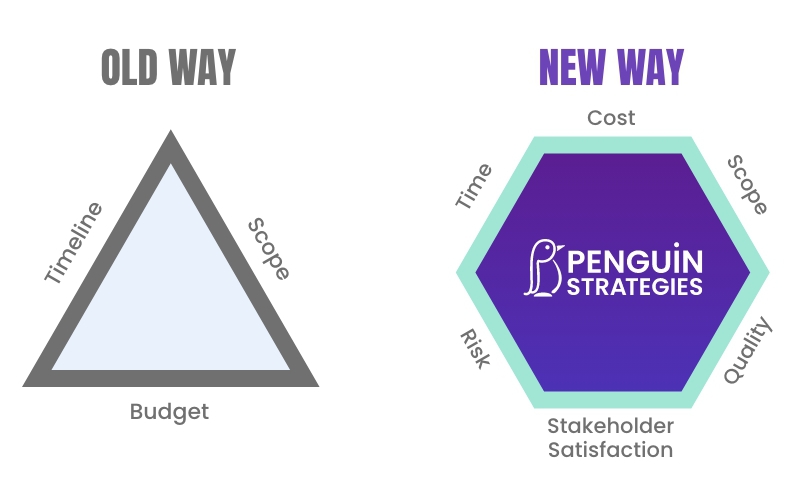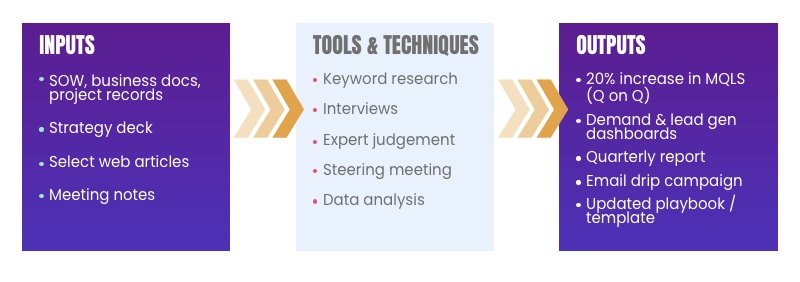
Here’s a peek at some of the internal processes we use at Penguin to deliver creative marketing activity on behalf of our clients.
Innovation and B2B - no, these are not contradictions in terms!
Natural language processing (NLP), Machine learning (ML) and AI-based technologies are playing an ever greater role in all forms of content and communication. One of the most significant areas of added value for us to preserve as B2B marketers is our creativity.
Creativity may seem daunting to some people, especially when they don’t consider themselves to be ‘creative types’ or when they’re surrounded by creative 'geniuses’ who appear time and again to throw out dazzling ideas as if from nowhere.
But while creative products are invariably sparkly and new, much of the creative process is timeless. It’s fueled by a twin-engine which, at least on the surface, may seem counterintuitive: strategy and organization.
In marketing and other closely related fields of communication, these are key features of project management.
The apparent mismatch comes from the sense that concepts like strategy, organization, and project management are matters of logical, rational, analytical, and so-called “left-brain” thinking, as opposed to the artistic, imaginative, and emotional characteristics of “right-brain” creativity.
This is, however, a crude and false dichotomy.
As marketers, we constantly seek to engage both hemispheres of the brain in concert. Doing so enables us to deliver all-round excellence, from process and planning through to campaign optimization, and everything in between.
Here are half a dozen things you can do to ensure you embark on the creative process in the right way, using some fundamental building blocks of project management.
#1: See marketing as strategy
Marketing means different things to different people. Here’s a wonderfully simple, jargon-free way of understanding it, courtesy of the entrepreneur and author Allan Dib:
If the circus is coming to town and you paint a sign saying “Circus Coming to the Showground Saturday,” that’s advertising.
If you put the sign on the back of an elephant and walk it into town, that’s promotion.
If the elephant walks through the mayor’s flower bed and the local newspaper writes a story about it, that’s publicity.
And if you get the mayor to laugh about it, that’s public relations.
If the town’s citizens go to the circus, you show them the many entertainment booths, explain how much fun they’ll have spending money at the booths, answer their questions and, ultimately, they spend a lot at the circus, that’s sales.
And if you planned the whole thing, that’s marketing.
Marketing is the strategy you use for getting your ideal target market to know you, like you, and trust you enough to become a customer.
Not only does this perspective tie in beautifully with inbound marketing philosophy (“getting your ideal target market to know you, like you and trust you”), but when viewed through this lens, marketing is more or less synonymous with strategy.
At the very least, there is no marketing without a strategic plan to enable you to achieve your goals, be they in the domain of demand generation, lead generation, or nurturing your contacts to create fertile ground for a sales pitch.
At any given moment, there are a number of products or services that the kinds of technology companies we serve might be pushing, directly or indirectly. These, in turn, are likely to suit the needs of different decision-makers and prospective users in a variety of ways.
Transforming these options into tangible, targeted offers takes high-level strategic thinking, and acute attention to detail.
#2: Identify as an innovator
As important as planning what you’re doing is seeing who you are. It’s important to recognize and appreciate your role as a creative one within an inherently creative industry. Whether in-house or at an agency like ours, innovation isn’t the exclusive domain of those with titles like Creative Director.
Whatever your role in digital marketing, be it as a strategist, graphic designer, copywriter, social media manager, or area specialist in SEO, PPC or technology, you’re in a position to double down on the innovation you bring to bear. This is one of the reasons why we collaborate and cross-pollinate ideas from across different business units in the way we do at Penguin.
#3: Understand your projects
Projects, by definition, entail innovation. Here’s how a project is defined by the Project Management Institute (PMI), a leading provider of global thought leadership in the field:
“A project is a temporary endeavor undertaken to create a unique product, service or result with a defined beginning and end, undertaken to meet unique goals and objectives, typically to bring about beneficial change or added value.”
Based on this understanding, aren’t we all engaged in projects all of the time?
When we initiate a new campaign with a client, it offers so much more value if it’s designed to meet defined objectives within a given timeframe. Campaigns may be short, running for 4-6 months before being fully revamped, or they may run on for several years with tweaks and optimization. In all instances, they should be seen and treated as projects.
Other examples might include a RevOps project to sync between HubSpot and other CRMs and tools in your tech stack, a website overhaul, or the creation of a new white paper or datasheet - the bread and butter, in other words, of what we do in B2B tech marketing!
#4: Manage your tradeoffs
Project management is only really necessary at all because of constraints. Unconstrained by time, money, or other project features, there would really be no need to manage what you’re working on from 20,000 feet – or five.
In reality, there are always limits, external or self-imposed. The question then becomes how to shape them in order to deliver the optimal outcome.
In project management, this problem used to be conceived of as a triangle, playing off budget against deadline against scope.
In today’s more sophisticated and comprehensive model, it’s useful to consider constraints as a hexagon:

* Source: PMI
None of these factors are more important than any other, though a case can be made for stakeholder satisfaction being "first among equals".
I mean, what would you prefer? To deliver on time, to spec, within budget - and yet somehow fail to satisfy those to whom you’re accountable, or to overshoot somewhere and delight everyone with a high-performing campaign which sets you entirely apart from your competitors?
As marketing project managers, we always face competing demands – and so effective management of expectations is something of an art form. Giving appropriate consideration to the weight of each demand enables us to make smart choices about resource allocation. It also enables us to smoothly steer whatever we’ve set out to create, through to completion.
#5: Use and adapt all available resources
By intentionally organizing, thinking through, and repurposing the relevant inputs, tools, and techniques we will use and deploy in a project, we effectively streamline the planning process. I highly recommend getting ahead of the curve on this whenever you embark on a new project.
Here’s a simplified, practical way of using company and 3rd party resources in a measured and effective way, and feeding back resources into your team’s organizational memory.

* Note that the inputs, processes and outputs included above are intended as examples. Source: PMI
Using and adapting existing resources means there’s no needless reinventing of the wheel. And most importantly, it frees up valuable time to add creative elements and new ideas in support of the specific goals and demands of the campaign or project you’re working on.
#6: Know when to brainstorm
Almost everyone recognizes the benefits of brainstorming - but just a fraction of people give thought to how they do it well. At least part of the secret is in the timing.
Just as the best spontaneity is said to take a great deal of planning, so the myth of the artist sitting down before a completely blank canvas to produce a masterpiece is just that - a myth. So in art, and so in marketing.
Brainstorm too early and you’ll likely get stuck or waste resources by barking up the wrong tree and being out of kilter with key decision-makers. Brainstorm too late and you may be needlessly restraining yourself in a straightjacket you didn’t need to be wearing.
Where’s the sweet spot?
When you run through the creative process systematically, it becomes clear. Establish a clear brief from which you can draw explicit goals, clarity about your target audience, and agreement on constraints. Are there must-have campaign features you need to think about up front? What’s the deadline to launch?
These considerations construct a concrete window frame through which you can do all your initial discovery and research.
Once you’re clear about where you’re going, you’re ready to set out different ways of getting there. That’s phase one of your brainstorm - to consider different routes to the same destination.
Any potentially feasible way of meeting goals can be thrown on the table - and the culture you cultivate should embody a “no stupid ideas” approach to allow for everyone’s creative juices to flow freely at this time.
It may sound cliche, but it’s often the seed of an idea that initially seemed ridiculous or implausible which turns out to deliver exactly what’s needed.
Once you’ve reviewed and weighed the pros and cons of all the options which emerge through the brainstorming, then and only then are you really ready to make a detailed plan to run with.
The common mistake made here - mainly because it’s fun - is to start thinking up the copy for the paid campaign you’re going to run before you’ve established whether there may be an alternative and better way of meeting your objective through an entirely different marketing tactic.
What about search engine marketing? A webinar series? Email campaigns? Rich media?
Copy, design, and other tactical considerations are best left to the next stage of the creative journey - once your market, your message, and your media are all firmly established.
Concluding remarks
The insights shared here merely scratch the surface but they hopefully serve to demonstrate that project management is right at the heart of what we’re doing and creating as marketers all the time. So it’s worth pausing every so often to reflect on how tools from within the world of professional project management can facilitate us in our jobs.
By conceiving of marketing through the prism of strategy, seeing ourselves as innovators, balancing constraints, utilizing all available resources, and brainstorming ideas at the right time in the creative process, you will be on the right track to results that systematically sparkle.
As the French novelist Gustave Flaubert advised, “Be regular and orderly in your life so that you may be violent and original in your work.”
If you like what you read, feel free to connect and follow me on LinkedIn.

by David Harris on June 29, 2023
David is a Director at Penguin and leads the B2B marketing agency team.





